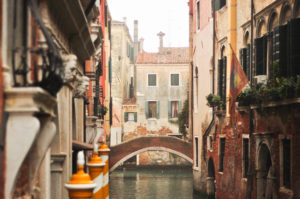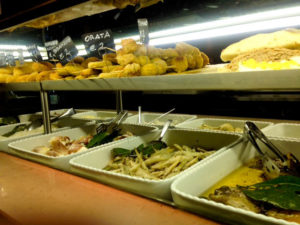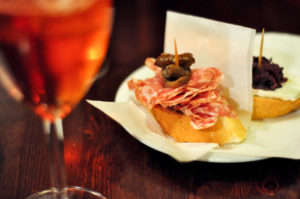By Katie Allie
Hi, I’m Katie. Once upon a time I was a kindergarten teacher, and life was pretty good. I loved coming home each day with paint on my hands and funny stories to tell. I got to travel a lot, too. Every time I had a break, I was somewhere new, managing to travel on a very tight budget and coming home with even better stories to tell. Since then, I’ve started my own travel consulting company, and I’ve experienced many memorable moments and mishaps. I’ve haggled, made friends and found hidden gems. I am hooked on getting lost in this great big world of ours, and I want to help you get lost, too.
I want to tell you about a surprisingly often-missed food event that takes place almost every day in Venice, just under the noses of thousands of well-meaning tourists sifting through my favorite of floating cities. I have a genuine love affair going on with Venice, but I can see where she is a tricky dame.

Most visitors will come for a day or two and endure lines at Doge’s Palace and €15 coffees in St. Mark’s Square. Come dusk they will seek out a place to rest, empty-bellied and exhausted, surprised to find they’re eating an outrageously overpriced Venetian meal that makes them feel . . . meh. It’s true: eating in Venice is generally very expensive and at times underwhelming—but it doesn’t have to be. I’m about to let you in on the not-too-hidden secret of enjoying Venice like a local without going broke.
Cicchetti, pronounced chi-KE-tee, is a specifically Venetian specialty—even the word itself is from the Venetian dialect, not Italian. It means small snacks, typically served in bacari, or small local bars where you can pop in for a drink and a small plate. They can be just that, or you can make a meal of them by hopping from bacari to bacari over the course of an evening. In their simplest form, they are slices of chewy bread topped with paper-thin slices of meat and sweet onions or colorful marinated seasonal vegetables soaked in olive oil. In other places, they’re crispy fried rissoles filled with salty pork, tender meatballs or—my favorite—velvety whipped codfish sitting atop a slice of polenta like a cloud. In any case, they’re delicious, filling and cheap at €1-€3 each.
 My own discovery of cicchetti was entirely accidental. Visiting a damp and misty Venice one December, I was warming up in a restaurant when I noticed the staff sliding trays of tiny snacks into a case by the bar. I questioned the waitress about ordering some, who informed me that, no, I could not order them. They were cicchetti, and they were to be eaten exclusively by patrons standing next to the bar. Lesson number one in the wonder that is cicchetti: you usually eat them standing up, with friends, at the bar. Occasionally, there will be a table and chairs, but don’t count on it. I may not have gotten to eat them at that moment, but I was sold. A portal to a delicious new universe had been opened, and I immediately dove in, mouth first.
My own discovery of cicchetti was entirely accidental. Visiting a damp and misty Venice one December, I was warming up in a restaurant when I noticed the staff sliding trays of tiny snacks into a case by the bar. I questioned the waitress about ordering some, who informed me that, no, I could not order them. They were cicchetti, and they were to be eaten exclusively by patrons standing next to the bar. Lesson number one in the wonder that is cicchetti: you usually eat them standing up, with friends, at the bar. Occasionally, there will be a table and chairs, but don’t count on it. I may not have gotten to eat them at that moment, but I was sold. A portal to a delicious new universe had been opened, and I immediately dove in, mouth first.
The second rule of cicchetti is to have a drink. Have what you like, but there are two traditional options, and I am a traditionalist at heart. First, you can order an ombra, literally meaning “shade,” which is a tiny glass of house wine. It is acceptable to have this at any time of day, by the way, with or without cicchetti. Start paying attention, and you’ll notice local men sitting outside at 10 in the morning with their first ombra of the day. Your second option, and my favorite by far, is a spritz. In most parts of Italy, there are three ways to order a spritz, but in Venice there are four—lucky you.
Spritz contain prosecco, a dash of soda water and a bitter liqueur. They’re potent and a perfect pair with your salty cicchetti misti. Your choice of liqueur in the spritz is what provides you with options. There is the benign aperol—a bright orange that is more sweet than bitter—that is perfect for first-timers; campari, my favorite, which is red and bitter; cynar, which is brown and earthy, made with extract from artichoke leaves, and the one only available in Venice, select is somewhere between bitter and sweet. Naturally, I suggest you try all four.
If you get up to the bar and you’re not sure what’s good, ask for cicchetti misti, a plate of typically four to eight bites—barkeep’s pick—so you can try a variety. I would shy away from asking for it if they’re especially busy, but don’t let a little gruff put you off. It’s part of the Venetian charm, I promise!
One more piece of advice: go early. Venice is not known for its nightlife, and a lot of places start closing up around 10 p.m. If you want to make a meal of your cicchetti, venture out around 6 p.m. and eat until you’ve run out of options. After a spritz and a few nibbles of polenta, I think you’ll begin to see Venice open her arms a bit and let you in.
 About the Author
About the Author
Katie Allie is a native West Virginian and a teacher by trade. Fascinated by maps, food culture and her students’ vacation photos, she took every opportunity she had to escape her classroom and explore one far-flung location after another. One day, it dawned on her that travel is what she should really be doing with her life, and she has never looked back. Today, Allie owns her own business as a travel consultant and loves to write about food and talk adventure.









4 Responses
Congratulations Katie!
This is a perfect fit for your multiple talents. Go after Rick Steves! He needs competition and you are the one.
I love Venice and I have actually been lost on the back streets..going in circles. But there is Kay’s something new to learn. Thanks for the info.
Welcome Home,
Thank you, Carol! Isn’t Venice the best? I don’t feel like you’ve truly been there until you’ve let yourself get lost a few times. I also don’t think there could be a more appropriate city in the world to start off a column called “Lost & Found.” You never know what’s around the next corner! 🙂
Amazing article! Take me with you sometime ????
As long as you love to eat and get lost, you wouldn’t have to twist my arm very hard!